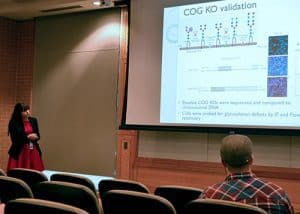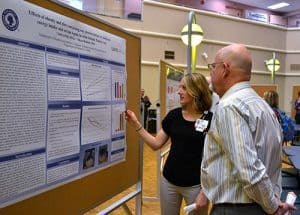Symposium Gives Students Chance to Present Research
| Feb. 25, 2016 | Students from the UAMS Graduate School presented their research Feb. 19 during the Graduate Student Association (GSA) Symposium, which was held in the BioMed buildings.
Eighteen students competed in the poster presentation portion of the symposium while eight students were selected, based on their abstracts, to present oral presentations about their research findings. Prizes ranged from $25 to $300.
Events where students can present their research are invaluable not only for those participating but also for the university, said Leslie Climer, secretary of the GSA and a fourth-year Ph.D. student in the Graduate School’s Interdisciplinary Biomedical Sciences program.

Jessica Blackburn details her findings during the oral presentation portion of the symposium. Blackburn won first place in the oral presentation category.
“Student research presentations are important so that the UAMS community understands all of its working components,” she said, adding that such understanding creates a “highly efficient” and “fantastic patient environment.”
The oral presentation portion of the symposium in which students are given 12 minutes to present their research and then three minutes for questions is what really makes the event unique, said Wezley Griffin, president of the GSA and a fourth-year Ph.D. candidate in the Graduate School’s Biochemistry and Molecular Biology program.
“It is quite difficult to surmise a complicated research project and all the data that a student has acquired for that project into a 12-minute presentation,” he said. “It is a skill that is invaluable in today’s fast-paced and highly competitive scientific career market.”
Students’ reasons for participating in the symposium were as varied as the research they explained on their posters.
For Rose Cooper, a first-year graduate student seeking a doctorate in pharmaceutical sciences, it was the encouragement of her advisor, Elvin Price, Pharm.D., Ph.D., which prompted her to enter the competition and present her research on metformin and diabetes.
“My advisor got excited about my preliminary data, and he wanted me to gain confidence by presenting this data,” she said.

Andrea Bell, a student in the Clinical Nutrition program, tells William Wessinger, Ph.D., about her research into the diet of obese Zucker rats.
Andrea Bell, who is in her second and final year of the Graduate School’s Clinical Nutrition master’s program, said she wanted to represent the nutrition community in the symposium. She studied why obese Zucker rats gained more weight when given a soy diet versus a casein diet.
Ayasha Thomason, A.P.R.N., who is in the Nursing Science Ph.D., program, said her research focuses on the sexual activity of older women in senior retirement communities, as well as the utilization of gynecologic health care in those settings.
Her research is ongoing, she said, adding that because she is a health care provider, she will be able to use her findings to directly improve care for her patients.
While the symposium was organized by the GSA’s officers, the abstracts, posters and oral presentations were judged by UAMS faculty. The judges were Venkat Yeruva, Ph.D.; Rosalia Simmen, Ph.D.; Vladimir Lupashin, Ph.D.; Mari Davidson, Ph.D.; Gur Kaushal, Ph.D.; Elisabet Borsheim, Ph.D.; Rafaela Feresin, Ph.D.; Jason Stumhofer, Ph.D.; Snehalata Pawar, Ph.D.; John Marecki, Ph.D.; Helen Benes, Ph.D.; Craig Forrest, Ph.D.; Grover Miller, Ph.D.; and Michael Jennings, Ph.D.
Four students won for their poster presentations. They were:
- First place, $100: Lee Ann Jolly, “HrasG12V and Pten loss cooperate in follicular thyroid cancer progression and metastasis, recruiting a tumor stroma enriched with myeloid and lymphoid derived immune cells,”
- Second place (tie), $50: Stephen Shrum, “Role of mitoBK channels in renal cold preservation,”
- Second place (tie), $50: Leslie Climer, “Rab GTPases provide the transient association of the COG Complex with Golgi membranes during vesicle tethering,”
- Third place, $25: Arundhati Gupta, Conditional Deletion of Essential Viral Genes in Mice to Better Define Mechanisms of Gammaherpesvirus Persistence and Disease.”
Three students took home prizes in the oral presentations. They were:
- First place, $300: Jessica Blackburn, “COG Complex complexities: Detailed characterization of a complete set of HEK293T cells lacking individual COG subunits,”
- Second place, $200: Debopam Ghosh, “An atypical splenic progenitor population supports antibody production during murine Plasmodium infection;”
- Third place, $100: Wezley Griffin, “The Structural Recognition of G-quadruplex DNA by PC4: How Does a ssDNA Binding Protein Decide?”
